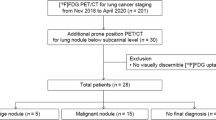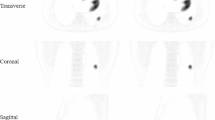Abstract
Objectives
This study aimed to investigate whether performing [18F]fluorodeoxyglucose ([18F]FDG) positron emission tomography/computed tomography (PET/CT) in the prone position could reduce [18F]FDG uptake in dependent lungs.
Methods
Patients who underwent [18F]FDG PET/CT in both supine and prone positions from October 2018 to September 2021 were reviewed retrospectively. [18F]FDG uptake of dependent and nondependent lungs was analysed visually and semi-quantitatively. A linear regression analysis was performed to examine the association between the mean standardised uptake value (SUVmean) and the Hounsfield unit (HU).
Results
A total of 135 patients (median age, 66 years [interquartile range: 58–75 years]; 80 men) were included. Dependent lungs showed significantly higher SUVmean and HU than nondependent lungs on supine position PET/CT (sPET/CT, 0.59 ± 0.14 vs. 0.36 ± 0.09, p < 0.001; − 671 ± 66 vs. − 802 ± 43, p < 0.001, respectively) and prone position PET/CT (pPET/CT, 0.45 ± 0.12 vs. 0.42 ± 0.08, p < 0.001; − 731 ± 67 vs. − 790 ± 40, p < 0.001, respectively). Linear regression analysis revealed a strong association between the SUVmean and HU in sPET/CT (R = 0.86, p < 0.001) and moderate association in pPET/CT (R = 0.65, p < 0.001). One hundred and fifteen patients (85.2%) had visually discernible [18F]FDG uptake in the posterior lung on sPET/CT, which disappeared on pPET/CT in all but one patient (0.7%, p < 0.001).
Conclusions
[18F]FDG uptake of the lung had moderate-to-strong associations with HU. Gravity-dependent opacity-related [18F]FDG uptake can be effectively reduced on prone position PET/CT.
Clinical relevance statement
Prone position PET/CT effectively reduces gravity-dependent opacity-related [18F]fluorodeoxyglucose uptake in the lung, potentially improving diagnostic accuracy in evaluating nodules in dependent lungs and offering a more accurate assessment of lung inflammation parameters in interstitial lung disease evaluations.
Key Points
• The study evaluated whether performing [18F]fluorodeoxyglucose ([18F]FDG) PET/CT could reduce [18F]FDG uptake in lungs.
• In prone and supine position PET/CT, the [18F]FDG uptake and Hounsfield unit were moderately to strongly associated.
• Prone position PET/CT can reduce gravity-dependent opacity-related [18F]FDG uptake by the posterior lung.




Similar content being viewed by others
Abbreviations
- [18F]FDG:
-
[18F]Fluorodeoxyglucose
- CT:
-
Computed tomography
- HU:
-
Hounsfield unit
- PET/CT:
-
Positron emission tomography/computed tomography
- pPET/CT:
-
Prone position PET/CT
- ROI:
-
Region of interest
- sPET/CT:
-
Supine position PET/CT
- SUVmean :
-
Mean standardised uptake value
- SUV-TFmean :
-
Tissue fraction corrected SUVmean
References
Austin JH, Müller NL, Friedman PJ et al (1996) Glossary of terms for CT of the lungs: recommendations of the Nomenclature Committee of the Fleischner Society. Radiology 200:327–331
Lee KN, Yoon SK, Sohn CH, Choi PJ, Webb WR (2002) Dependent lung opacity at thin-section CT: evaluation by spirometrically-gated CT of the influence of lung volume. Korean J Radiol 3:24–29
Gerbaudo VH, Julius B (2007) Anatomo-metabolic characteristics of atelectasis in F-18 FDG-PET/CT imaging. Eur J Radiol 64:401–405
Bu L, Tu N, Wang K et al (2022) Relationship between 18F-FDG PET/CT semi-quantitative parameters and International Association for the Study of Lung Cancer, American Thoracic Society/European Respiratory Society Classification in Lung Adenocarcinomas. Korean J Radiol 23:112–123
Adams S, Baum R, Rink T, Schumm-Dräger PM, Usadel KH, Hör G (1998) Limited value of fluorine-18 fluorodeoxyglucose positron emission tomography for the imaging of neuroendocrine tumours. Eur J Nucl Med 25:79–83
Inoue K, Okada K, Taki Y, Goto R, Kinomura S, Fukuda H (2009) (18)FDG uptake associated with CT density on PET/CT in lungs with and without chronic interstitial lung diseases. Ann Nucl Med 23:277–281
Lambrou T, Groves AM, Erlandsson K et al (2011) The importance of correction for tissue fraction effects in lung PET: preliminary findings. Eur J Nucl Med Mol Imaging 38:2238–2246
Kashiwabara K, Kohshi S (2006) Additional computed tomography scans in the prone position to distinguish early interstitial lung disease from dependent density on helical computed tomography screening patient characteristics. Respirology 11:482–487
Kazerooni EA (2001) High-resolution CT of the lungs. AJR Am J Roentgenol 177:501–519
Lee HJ, Son HJ, Yun M et al (2021) Prone position [18F]FDG PET/CT to reduce respiratory motion artefacts in the evaluation of lung nodules. Eur Radiol 31:4606–4614
Verschakelen JA, Van fraeyenhoven L, Laureys G, Demedts M, Baert AL (1993) Differences in CT density between dependent and nondependent portions of the lung: influence of lung volume. AJR Am J Roentgenol 161:713–717
Galiatsou E, Kostanti E, Svarna E et al (2006) Prone position augments recruitment and prevents alveolar overinflation in acute lung injury. Am J Respir Crit Care Med 174:187–197
Hofman MS, Hicks RJ (2016) How we read oncologic FDG PET/CT. Cancer Imaging 16:35
Ziai P, Hayeri MR, Salei A et al (2016) Role of optimal quantification of FDG PET imaging in the clinical practice of radiology. Radiographics 36:481–496
Song YH, Moon JW, Kim YN et al (2022) Tissue fraction correction and visual analysis increase diagnostic sensitivity in predicting malignancy of ground-glass nodules on [18F]FDG PET/CT: a bicenter retrospective study. Diagnostics (Basel) 12:1292
Kawabe J, Okamura T, Shakudo M et al (1999) Thallium and FDG uptake by atelectasis with bronchogenic carcinoma. Ann Nucl Med 13:273–276
Johnson NJ, Luks AM, Glenny RW (2017) Gas exchange in the prone posture. Respir Care 62:1097–1110
Chen DL, Cheriyan J, Chilvers ER et al (2017) Quantification of lung PET images: challenges and opportunities. J Nucl Med 58:201–207
Cheng G, Alavi A, Lim E, Werner TJ, Del Bello CV, Akers SR (2013) Dynamic changes of FDG uptake and clearance in normal tissues. Mol Imaging Biol 15:345–352
Chen R, Li J, Zhou X, Liu J, Huang G (2017) Fructose-1,6-bisphosphatase 1 reduces 18F FDG uptake in hepatocellular carcinoma. Radiology 284:844–853
Lee SH, Park JS, Kim H et al (2021) Glycolysis on F-18 FDG PET/CT is superior to amino acid metabolism on C-11 methionine PET/CT in identifying advanced renal cell carcinoma at staging. Cancers (Basel) 13:2381
Chen DL, Schiebler ML, Goo JM, van Beek EJR (2017) PET imaging approaches for inflammatory lung diseases: current concepts and future directions. Eur J Radiol 86:371–376
Justet A, Laurent-Bellue A, Thabut G et al (2017) [18F]FDG PET/CT predicts progression-free survival in patients with idiopathic pulmonary fibrosis. Respir Res 18:74
Nobashi T, Kubo T, Nakamoto Y et al (2016) 18F-FDG uptake in less affected lung field provides prognostic stratification in patients with interstitial lung disease. J Nucl Med 57:1899–1904
Yoon HY, Lee SH, Ha S, Ryu JS, Song JW (2021) The value of 18F-FDG PET/CT in evaluating disease severity and prognosis in idiopathic pulmonary fibrosis patients. J Korean Med Sci 36:e257
Yoon HY, Lee SH, Ha S, Ryu JS, Song JW (2021) 18F-FDG PET/CT predicts acute exacerbation in idiopathic pulmonary fibrosis after thoracic surgery. BMC Pulm Med 21:294
Shin KM, Choi J, Chae KJ et al (2020) Quantitative CT-based image registration metrics provide different ventilation and lung motion patterns in prone and supine positions in healthy subjects. Respir Res 21:254
Funding
This study has received funding from Hallym University Research Fund, 2021 (HURF-2021–30).
Author information
Authors and Affiliations
Corresponding author
Ethics declarations
Guarantor
The scientific guarantor of this publication is Suk Hyun Lee.
Conflict of interest
The authors of this manuscript declare no relationships with any companies whose products or services may be related to the subject matter of the article.
Statistics and biometry
No complex statistical methods were necessary for this paper.
Informed consent
Written informed consent was waived by the Institutional Review Board.
Ethical approval
Institutional Review Board approval was obtained.
Study subjects or cohorts overlap
Some study subjects have been previously reported in our previous article (Eur Radiol (2021) 31:4606–4614). This study included 135 patients who underwent PET/CT scans in both supine and prone positions from October 2018 to September 2021 at Kangnam Sacred Heart Hospital. Our previously published study included 28 patients who underwent PET/CT scans in both supine and prone positions from November 2018 to April 2020. Therefore, a significant number of patients overlap. However, the previous study was to find out whether prone position PET/CT could reduce the respiratory motion artefact of the lung nodule, and the current study was to find out if it could reduce the gravity-dependent opacity-related [18F]FDG uptake of the normal lung. Therefore, the two studies have completely different study designs.
Methodology
• retrospective
• observational
• performed at one institution
Additional information
Publisher's note
Springer Nature remains neutral with regard to jurisdictional claims in published maps and institutional affiliations.
Rights and permissions
Springer Nature or its licensor (e.g. a society or other partner) holds exclusive rights to this article under a publishing agreement with the author(s) or other rightsholder(s); author self-archiving of the accepted manuscript version of this article is solely governed by the terms of such publishing agreement and applicable law.
About this article
Cite this article
Song, Y.H., Moon, J.W., Kim, Y.N. et al. Prone position PET/CT is useful in reducing gravity-dependent opacity-related [18F]fluorodeoxyglucose uptake. Eur Radiol 33, 8270–8278 (2023). https://doi.org/10.1007/s00330-023-09831-6
Received:
Revised:
Accepted:
Published:
Issue Date:
DOI: https://doi.org/10.1007/s00330-023-09831-6




